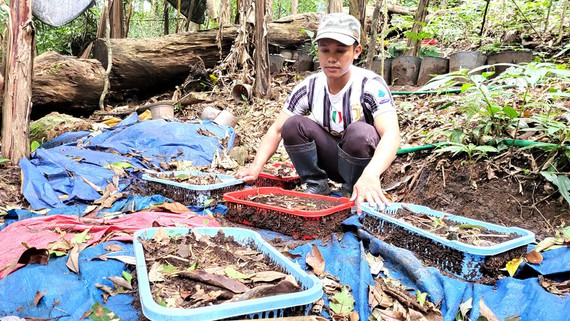 Society
Society

 |
A Thuất's troubled ginseng garden. — Photo: sggp.org.vn
KON TUM — Ginseng farming households in the Central Highlands province of Kon Tum are deep in debt due to a widespread crop failure of panax ginseng and local authorities are seeking solutions for the matter.
When the government recognised panax ginseng as a national treasure, many farmers in the Central Highlands invested in this type of root, hoping it would bring back strong profits. However, due to unexpected weather, a lot of these roots have died in the recent weeks in Tu Mơ Rông and Đắk Glei District, Kon Tum Province.
A Thuất, a farmer in Măng Ri commune, Tu Mơ Rông District said that because of prior success with the crop many years ago, he decided to borrow a bank loan of VNĐ100 million (US$4,300) from to expand the cultivation area.
But recently, his family found out that 700 ginseng roots of their farm had died. They lost VNĐ250 million and are now in debt.
A Gẹo, another ginseng farmer in Măng Ri, suffered the same losses as 500 out of 550 roots of his farm also died. His family had borrowed VNĐ50 million from a bank.
Nguyễn Minh Trí, deputy chairman of Măng Ri Commune People's Committee, said that after an initial inspection, there are 274 ginseng farming households with ginseng that has died due to pests and hail.
Two communes in Đắk Glei District grow panax ginseng also report some 13,500 dead ginseng roots.
These roots have prices ranging from VNĐ300,000 to around VNĐ7,000,000 per root.
“Growing ginseng is not easy," Trí said. "With the mass dying of ginseng happening right now, many ginseng farming households are unable to pay the loans that they borrowed from the bank.”
The Kon Tum Province's Sub-department of Crop Production and Plant Protection said it investigated the problem and found the main causes of the death were a lack of technical skills and sudden climate change that led to thermal shock.
Since March, areas where panax ginseng is grown have had a lot of rain, as well as frost, cloudy weather and high humidity. This condition creates an environment for many harmful fungi, such as Rhizoctonia solani and Phytophthora spp., to grow and cause infection.
The department advised the districts to clean farming areas and separate healthy roots from dying ones to prevent the spreading of fungi.
Another method to prevent the spreading of fungi and rain from hitting the roots directly is to cover farming areas.
Phạm Xuân Quang, deputy chairman of Tu Mơ Rông District People's Committee, said that the Kon Tum Province's Department of Agriculture and Rural Development issued a planting guideline for panax ginseng. However, this guideline was outdated and farmers met challenges that the guideline did not address adequately.
Quang said that to fix these problems the district committee will ask the department to develop a new and standard guideline for panax ginseng farmers.
They will train farmers while also gathering data on the number of ginseng farming households that take loans from banks to negotiate an extension or a freeze of their current debts. — VNS